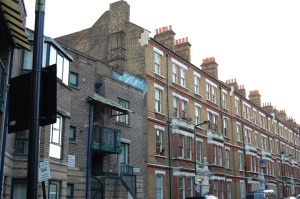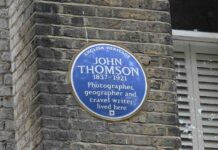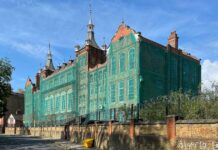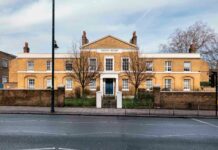Brixton has some of the best remaining murals in London. Brixton Blog got Ruth Miller, from the London Mural Preservation Society, to take us on a tour
Ruth Miller wanted to organise a walk around Brixton murals, inspired by a thread about Brixton walks on the urban 75 forum, but when she set about researching the murals she found there was almost no information out there. So she ordered up books, searched the archives, contacted the artists and, in 2010, set up the London Mural Preservation Society. Now, finally, she can do those Brixton Mural tours – and she took me on one this month.
First up was the Brixton Academy Mural, above, completed in 1982 by Stephen Pusey. Like many of the murals in Brixton, it was commissioned by the council after the Brixton riots and its theme is obviously racial harmony. There’s something a bit tacky but undeniably endearing about it. The children are scaled up all wrong and the colours, having been painted in pure pigment, are still glaringly bright. Pusey took part in consultations with the residents in the area and, unsurprisingly, it turned out that they didn’t want anything too depressing in the post-riot landscape. So the bright colours are fitting. “If you watch an old Grange Hill, that’s kind of what the playground in this mural is like”, says Miller. “But it really was like that – the kids were a bit poorer and people weren’t that well off to buy their kids cool clothes”.
The mural cost thousands to make, but once it was built there was no responsibility on the part of the council or the owner of the wall (in this case the 02 Academy) to maintain or repair the painting. It is now fading, peeling and being destroyed by bad weather. This is a story we will encounter again and again on the tour, and one Miller intends to put right.
Can you see all the Lambeth symbols in the mural above? The bricks represent Brixton (think about the platforms at Brixton Underground), the Swan is Stockwell, the gates are there for Gateley Rd, and the Brixton Rec logo is in there somewhere too. This painting, along with the one below, is on Bellefields Rd and was painted in 1987 by a collection of women from the London Wall Art Group.
Ruth Miller has gone to great lengths to talk to the artists involved in the mural painting project of the 1980s – and there were an extraordinary number of them. When someone added to Wikipedia the names of the artists behind the Brixton Station murals (see below) – Angie Biltcliffe and Karen Smith -, she went on a hunt to find them. But Angie has just died in November 2010 and Miller still hasn’t been able to locate Karen Smith. Their works, however, are some of the best in Brixton.
“I really like these. You can see the one at the top of the stairs when the train arrives and they both really reflect the atmosphere of the market – the diversity of foods and strange things you can find there. But they’re not even protected by a varnish or anything.”
What colours!
And now for the best of them all. Brixton’s most famous mural – Nuclear Dawn. It was painted by Brian Barnes and Dale McCrea between 1980-1981, at the peak of the Cold War, and this year it will be 30 years old. On 20 February, Brian Barnes will be giving a talk on the work at the Dogstar pub.
Nuclear Dawn was one of several ‘peace murals’ commissioned around London during this time, including Ray Walker’s peace mural on Dalston Lane. Nuclear Dawn features a frightening skeletal figure walking over London as nuclear bombs drop and, under the Houses of Parliament, the elected politicians including Thatcher hide in a bunker.
Sadly that bunker is now covered by graffiti and much of the mural has been damaged by trees growing too close to the wall. Ruth Miller succeeded in getting the trees cut down last year, but she is still hoping for some more extensive renovation to preserve the painting properly. “It’s my favourite mural”, she says. “As kids we were very scared of it”.
There were two more peace murals in Brixton, but they were covered over when new housing was built on Vining St and Rushcroft Rd. You can still get a glimpse of them if you look carefully:
This is by Fujiyama, facing Atlantic Rd. And if you walk in the opposite direction, along Vining Street to Rushcroft Rd, and look up, you’ll see this flash of blue:
It’s poor solace for what we’re missing out on, though. This flickr photo shows the original on Vining Street.
It would be a real shame if any more murals in Brixton were lost or destroyed. And there sure are more of them. Below is ‘Big Splash’ on Glenelg Rd, a rather joyful and idealised painting of life in Brixton. The river is based on the Effra, the vases around the side make reference to the Royal Doulton factory once based in Lambeth and the children are all local kids.
Our final mural is a surprising one. Tucked behind Acre Lane on Mauleverer Rd, it is absolutely huge. The picture below shows only one part of it. It was inspired by Brockwell Park, but the best bit about it is that a resident living opposite reputedly asked for a Caribbean beach view to be inserted into the Brockwell Park pavillion. The perfect view to wake up to every morning…
To find out more about the London Murals Preservation Society and to take part in Ruth Miller’s mural tours (which take in more than we saw here), visit the website: http://londonmuralpreservationsociety.wordpress.com/
Brian Barnes, who painted Nuclear Dawn, will be speaking upstairs at the Dogstar at 12.30pm on 20 February in celebration of the 30-year anniversary of Nuclear Dawn. See here for details.

















[…] Winter (via Brixton Blog and London Mural Preservation […]
[…] Sunday: The best thing to do this Sunday after two days of hard dancing? Brian Barnes, the artist behind the Nuclear Dawn mural on Coldharbour Lane, is giving a talk on the history of the peace mural at 12.30pm upstairs at the Dogstar. Entry is free. For a taste of what it might be like, see our blog post on Brixton murals here. […]
[…] you enjoyed Brixton Blog’s post about local murals, get yourself to the Dogstar for 12.30 to hear Brian Barnes, who painted Nuclear Dawn, speaking […]
There’s also a badly faded mural of Brixton Windmill on Lyham Road.
Ruth Miller is to Brixton Murals what John Betjeman was to St Pancras. Help and cherish this woman!
Just along the road from the Mauleverer Road mural is one of two horses outside their stable, which is so badly faded now you can hardly see it.